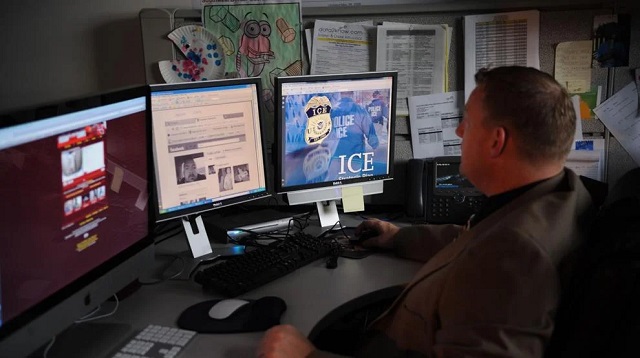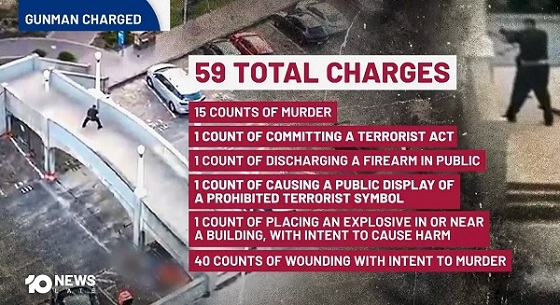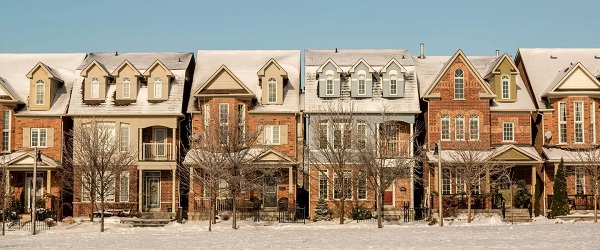Crime
IG: ICE incapable of monitoring unaccompanied minors released into US

An agent with the U.S. Immigration and Customs Enforcement Homeland Security Investigation team is scanning the Internet for child sexual exploitation.
From The Center Square
Earlier this year, Grassley led a group of 44 senators to introduce a resolution to reform ORR oversight after multiple allegations of sexual abuse of UACs were reported and more than 100,000 UACs appear to be missing, The Center Square reported.
The Inspector General for the U.S. Department of Homeland Security issued a management alert to U.S. Immigration and Customs Enforcement to make it aware of an urgent issue: ICE is incapable of monitoring hundreds of thousands of unaccompanied children (UACs) released into the country by the Biden-Harris administration.
“We found ICE cannot always monitor the location and status of unaccompanied migrant children who are released from DHS and HHS custody,” HHS Inspector General Joseph Cuffari said in a memo to the deputy director of ICE.
“Without an ability to monitor the location and status of UCs, ICE has no assurance UCs are safe from trafficking, exploitation, or forced labor,” the alert states.
In response, U.S. Sen. Chuck Grassley, R-Iowa, requested additional information from HHS about UAC oversight, saying, “lax vetting has placed migrant children in grave danger of exploitation and abuse and makes locating these children after placement difficult, something I fear hinders the work of DHS as well.”
The DHS OIG report found that not only was ICE incapable of monitoring the location and status of all UACs but it was also incapable of initiating removal proceedings as needed.
ICE transferred more than 448,000 UACs to the care of the U.S. Department of Health and Human Services’ Office of Refugee Resettlement, which is responsible for their care, from fiscal years 2019 to 2023. Over the same time period, ICE neglected to issue notices to appear (NTAs) before an immigration judge for 65% of UACs transferred from DHS custody, according to the OIG report, leaving them in limbo.
Of the 448,000 UACs who illegally entered the country and were placed with sponsors through ORR, the majority arrived under the Biden-Harris administration: roughly 366,000, or 81%, between fiscal years 2021 and 2023, Grassley notes.
The report also found that ICE agents didn’t issue NTAs for immigration court hearings to all UACs who were flagged to be removed from the country, despite being required by federal law to do so, the OIG report found.
ICE failed to issue NTAs to at least more than 291,000 UACs who should have been placed in removal proceedings but weren’t, as of May 2024, according to the report.
“ICE was not able to account for the location of all UCs who were released by HHS and did not appear as scheduled in immigration court,” the report states.
At least 32,000 UACs who were given NTAs didn’t show up to their immigration court hearing and ICE doesn’t know where they are. Additionally, ICE didn’t always inform ORR when UACs didn’t show up, contributing to multiple agencies not being able to account for their whereabouts, the report found.
To make matter worse, ICE Enforcement and Removal Operations officers weren’t looking for them, according to the report.
Officers from only one of eight ICE ERO field offices that OIG staff visited said they attempted to locate missing UACs.
Federal agencies not scheduling immigration court dates appears to be a consistent problem, according to several audit reports.
From January 2021 to February 2024, one audit found that 200,000 asylum or other immigration cases were dismissed because DHS didn’t file paperwork with the courts in time for scheduled hearings, The Center Square reported.
Prior to that, 50,000 illegal foreign nationals released into the U.S. by ICE failed to report to their deportation proceedings during a five-month period analyzed in 2021, The Center Square reported. ICE also didn’t have court information on more than 40,000 individuals it’s supposed to prosecute, according to the report, and more than 270,000 illegal foreign nationals were released into the U.S. “with little chance for removal” during that time period, the report found.
Not knowing the whereabouts of the UACs “occurred, in part, because ICE does not have an automated process for sharing information internally between the Office of the Principal Legal Advisor (OPLA) and ERO, and externally with stakeholders, such as HHS and the Department of Justice (DOJ), regarding UCs who do not appear in immigration court,” the OIG report found.
ICE-ERO also hasn’t developed a formal policy or process to find UACs who don’t show up to their court dates, has limited oversight for monitoring them, and faces resource limitations, the OIG says. Nevertheless, “ICE must take immediate action to ensure the safety” of UACs and provide it with the corrective action it will take.
UACs who miss their court dates “are considered at higher risk for trafficking, exploitation, or forced labor,” the OIG says.
Earlier this year, Grassley led a group of 44 senators to introduce a resolution to reform ORR oversight after multiple allegations of sexual abuse of UACs were reported and more than 100,000 UACs appear to be missing, The Center Square reported.
Texas, California and Florida have received the most UACs of all states, The Center Square first reported, with each state receiving record numbers in fiscal 2023. For some states, fiscal 2023 numbers represent 20% or more of the total they received since 2015 or dwarfed previous years.
Crime
The Uncomfortable Demographics of Islamist Bloodshed—and Why “Islamophobia” Deflection Increases the Threat


Addressing realities directly is the only path toward protecting communities, confronting extremism, and preventing further loss of life, Canadian national security expert argues.
After attacks by Islamic extremists, a familiar pattern follows. Debate erupts. Commentary and interviews flood the media. Op-eds, narratives, talking points, and competing interpretations proliferate in the immediate aftermath of bloodshed. The brief interval since the Bondi beach attack is no exception.
Many of these responses condemn the violence and call for solidarity between Muslims and non-Muslims, as well as for broader societal unity. Their core message is commendable, and I support it: extremist violence is horrific, societies must stand united, and communities most commonly targeted by Islamic extremists—Jews, Christians, non-Muslim minorities, and moderate Muslims—deserve to live in safety and be protected.
Yet many of these info-space engagements miss the mark or cater to a narrow audience of wonks. A recurring concern is that, at some point, many of these engagements suggest, infer, or outright insinuate that non-Muslims, or predominantly non-Muslim societies, are somehow expected or obligated to interpret these attacks through an Islamic or Muslim-impact lens. This framing is frequently reinforced by a familiar “not a true Muslim” narrative regarding the perpetrators, alongside warnings about the risks of Islamophobia.
These misaligned expectations collide with a number of uncomfortable but unavoidable truths. Extremist groups such as ISIS, Al-Qaeda, Hamas, Hezbollah, and decentralized attackers with no formal affiliations have repeatedly and explicitly justified their violence through interpretations of Islamic texts and Islamic history. While most Muslims reject these interpretations, it remains equally true that large, dynamic groups of Muslims worldwide do not—and that these groups are well prepared to, and regularly do, use violence to advance their version of Islam.
Islamic extremist movements do not, and did not, emerge in a vacuum. They draw from the broader Islamic context. This fact is observable, persistent, and cannot be wished or washed away, no matter how hard some may try or many may wish otherwise.
Given this reality, it follows that for most non-Muslims—many of whom do not have detailed knowledge of Islam, its internal theological debates, historical divisions, or political evolution—and for a considerable number of Muslims as well, Islamic extremist violence is perceived as connected to Islam as it manifests globally. This perception persists regardless of nuance, disclaimers, or internal distinctions within the faith and among its followers.
THE COST OF DENIAL AND DEFLECTION
Denying or deflecting from these observable connections prevents society from addressing the central issues following an Islamic extremist attack in a Western country: the fatalities and injuries, how the violence is perceived and experienced by surviving victims, how it is experienced and understood by the majority non-Muslim population, how it is interpreted by non-Muslim governments responsible for public safety, and how it is received by allied nations. Worse, refusing to confront these difficult truths—or branding legitimate concerns as Islamophobia—creates a vacuum, one readily filled by extremist voices and adversarial actors eager to poison and pollute the discussion.
Following such attacks, in addition to thinking first of the direct victims, I sympathize with my Muslim family, friends, colleagues, moderate Muslims worldwide, and Muslim victims of Islamic extremism, particularly given that anti-Muslim bigotry is a real problem they face. For Muslim victims of Islamic extremism, that bigotry constitutes a second blow they must endure. Personal sympathy, however, does not translate into an obligation to center Muslim communal concerns when they were not the targets of the attack. Nor does it impose a public obligation or override how societies can, do, or should process and respond to violence directed at them by Islamic extremists.
As it applies to the general public in Western nations, the principle is simple: there should be no expectation that non-Muslims consider Islam, inter-Islamic identity conflicts, internal theological disputes, or the broader impact on the global Muslim community, when responding to attacks carried out by Islamic extremists. That is, unless Muslims were the victims, in which case some consideration is appropriate.
Quite bluntly, non-Muslims are not required to do so and are entitled to reject and push back against any suggestion that they must or should. Pointedly, they are not Muslims, a fact far too many now seem to overlook.
The arguments presented here will be uncomfortable for many and will likely provoke polarizing discussion. Nonetheless, they articulate an important, human-centered position regarding how Islamic extremist attacks in Western nations are commonly interpreted and understood by non-Muslim majority populations.
Non-Muslims are free to give no consideration to Muslim interests at any time, particularly following an Islamic extremist attack against non-Muslims in a non-Muslim country. The sole exception is that governments retain an obligation to ensure the safety and protection of their Muslim citizens, who face real and heightened threats during these periods. This does not suggest that non-Muslims cannot consider Muslim community members; it simply affirms that they are under no obligation to do so.
The impulse for Muslims to distance moderate Muslims and Islam from extremist attacks—such as the targeting of Jews in Australia or foiled Christmas market plots in Poland and Germany—is understandable.
Muslims do so to protect their own interests, the interests of fellow Muslims, and the reputation of Islam itself. Yet this impulse frequently collapses into the “No True Scotsman” fallacy, pointing to peaceful Muslims as the baseline while asserting that the attackers were not “true Muslims.”
Such claims oversimplify the reality of Islam as it manifests globally and fail to address the legitimate political and social consequences that follow Islamic extremist attacks in predominantly non-Muslim Western societies. These deflections frequently produce unintended effects, such as strengthening anti-Muslim extremist sentiments and movements and undermining efforts to diminish them.
The central issue for public discourse after an Islamic extremist attack is not debating whether the perpetrators were “true” or “false” Muslims, nor assessing downstream impacts on Muslim communities—unless they were the targets.
It is a societal effort to understand why radical ideologies continue to emerge from varying—yet often overlapping—interpretations of Islam, how political struggles within the Muslim world contribute to these ideologies, and how non-Muslim-majority Western countries can realistically and effectively confront and mitigate threats related to Islamic extremism before the next attack occurs and more non-Muslim and Muslim lives are lost.
Addressing these realities directly is the only path toward protecting communities, confronting extremism, and preventing further loss of life.
Ian Bradbury, a global security specialist with over 25 years experience, transitioned from Defence and NatSec roles to found Terra Nova Strategic Management (2009) and 1NAEF (2014). A TEDx, UN, NATO, and Parliament speaker, he focuses on terrorism, hybrid warfare, conflict aid, stability operations, and geo-strategy.
The Bureau is a reader-supported publication.
To receive new posts and support my work, consider becoming a free or paid subscriber.
Crime
Brown University shooter dead of apparent self-inflicted gunshot wound

From The Center Square
By
Rhode Island officials said the suspected gunman in the Brown University mass shooting has been found dead of an apparent self-inflicted gunshot wound, more than 50 miles away in a storage facility in southern New Hampshire.
The shooter was identified as Claudio Manuel Neves-Valente, a 48-year-old Brown student and Portuguese national. Neves-Valente was found dead with a satchel containing two firearms inside in the storage facility, authorities said.
“He took his own life tonight,” Providence police chief Oscar Perez said at a press conference, noting that local, state and federal law officials spent days poring over video evidence, license plate data and hundreds of investigative tips in pursuit of the suspect.
Perez credited cooperation between federal state and local law enforcement officials, as well as the Providence community, which he said provided the video evidence needed to help authorities crack the case.
“The community stepped up,” he said. “It was all about groundwork, public assistance, interviews with individuals, and good old fashioned policing.”
Rhode Island Attorney General Peter Neronha said the “person of interest” identified by private videos contacted authorities on Wednesday and provided information that led to his whereabouts.
“He blew the case right open, blew it open,” Neronha said. “That person led us to the car, which led us to the name, which led us to the photograph of that individual.”
“And that’s how these cases sometimes go,” he said. “You can feel like you’re not making a lot of progress. You can feel like you’re chasing leaves and they don’t work out. But the team keeps going.”
The discovery of the suspect’s body caps an intense six-day manhunt spanning several New England states, which put communities from Providence to southern New Hampshire on edge.
“We got him,” FBI special agent in charge for Boston Ted Docks said at Thursday night’s briefing. “Even though the suspect was found dead tonight our work is not done. There are many questions that need to be answered.”
He said the FBI deployed around 500 agents to assist local authorities in the investigation, in addition to offering a $50,000 reward. He says that officials are still looking into the suspect’s motive.
Two students were killed and nine others were injured in the Brown University shooting Saturday, which happened when an undetected gunman entered the Barus and Holley building on campus, where students were taking exams before the holiday break. Providence authorities briefly detained a person in the shooting earlier in the week, but then released them.
Investigators said they are also examining the possibility that the Brown case is connected to the killing of a Massachusetts Institute of Technology professor in his hometown.
An unidentified gunman shot MIT professor Nuno Loureiro multiple times inside his home in Brookline, about 50 miles north of Providence, according to authorities. He died at a local hospital on Tuesday.
Leah Foley, U.S. attorney for Massachusetts, was expected to hold a news briefing late Thursday night to discuss the connection with the MIT shooting.
-

 armed forces1 day ago
armed forces1 day agoOttawa’s Newly Released Defence Plan Crosses a Dangerous Line
-

 espionage1 day ago
espionage1 day agoCarney Floor Crossing Raises Counterintelligence Questions aimed at China, Former Senior Mountie Argues
-

 Health1 day ago
Health1 day agoAll 12 Vaccinated vs. Unvaccinated Studies Found the Same Thing: Unvaccinated Children Are Far Healthier
-

 Energy1 day ago
Energy1 day ago75 per cent of Canadians support the construction of new pipelines to the East Coast and British Columbia
-

 Opinion1 day ago
Opinion1 day agoPope Leo XIV’s Christmas night homily
-

 armed forces1 day ago
armed forces1 day agoRemembering Afghanistan and the sacrifices of our military families
-

 Fraser Institute16 hours ago
Fraser Institute16 hours agoCarney government sowing seeds for corruption in Ottawa
-

 Fraser Institute1 day ago
Fraser Institute1 day agoHow to talk about housing at the holiday dinner table





